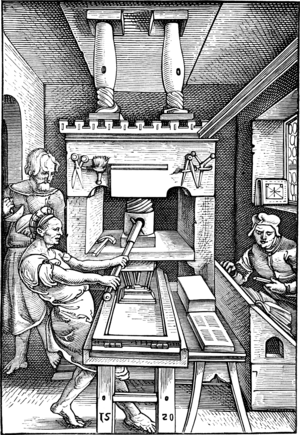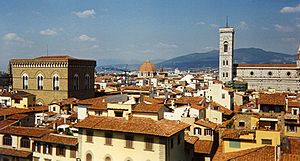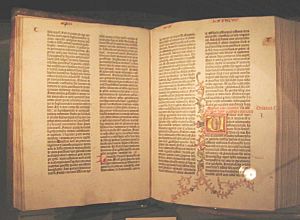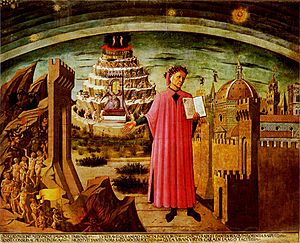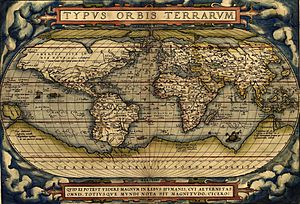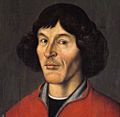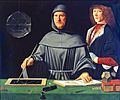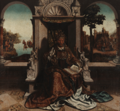Renaissance facts for kids
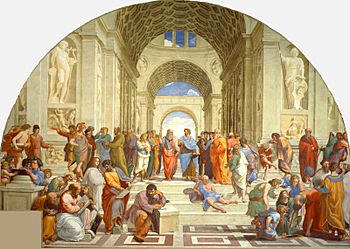
The Renaissance is a period in the history of Europe beginning in about 1400, and following the Medieval period.
"Renaissance" is a French word meaning "rebirth". The period is called by this name because at that time, people started taking an interest in the learning of ancient times, in particular, the learning of Ancient Greece and Rome. The Renaissance was seen as a "rebirth" of that learning. The Renaissance is often said to be the start of the "modern age".
During the Renaissance, there were many famous artists, many writers and many philosophers. Many people studied mathematics and different sciences. A person who is clever at a great number of things is sometimes called a "Renaissance man". Leonardo da Vinci, who was a painter, a scientist, a musician and a philosopher, is the most famous Renaissance Man.
The Renaissance started in Italy but soon spread across the whole of Europe. In Italy, the time is divided into three periods:
- Early Renaissance
- High Renaissance
- Late Renaissance
Following the Mannerist period was the Baroque period which also spread across Europe from about 1600. Outside Italy, it can be hard to tell where the Renaissance period ends and Baroque begins.
Contents
Causes of the Renaissance
In the Middle Ages, most artistic, legal, and historical production took place in and around books, which were produced in and belonged to monasteries, churches, universities, and the individuals who could afford them. Books were produced entirely by hand, which is why they were called manuscripts; illuminated manuscripts refer to those with hand-colored, drawn, and gilded pictures.
Most books at that time were written in Latin, Greek, and Roman which was used in the Catholic Church. Only priests and well-educated people read Latin then. People were forbidden by law from translating the Bible into Italian, English, German, French, or other "local" languages.
Around 1440 the first printed books were made in Europe. The way of printing quickly improved so that large books like the Bible could be made and sold cheaply. It took 300 calf skins or 100 pig skins to print the Bible. The printers then began to print everything that they thought was interesting:- Ancient Greek and Roman writings, poetry, plays, lives of the saints, mathematics textbooks, medical textbooks, Christian stories, books about animals and monsters, advice to princes as to how to rule their people and maps of the world.
Before the invention of the printing press, knowledge belonged to priests, monasteries, and universities. Suddenly, many thousands of people, even merchants could learn far more than they ever could before.
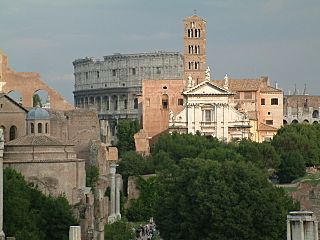
Ancient Roman remains
The time of Ancient Greece and Rome, when there were many philosophers, writers, painters, sculptors, architects and mathematicians was seen by people as a Golden Age, a time when things were beautiful, well-organised and well-run. This time had lasted from about 400 BC to about 400 AD.
In the year 1400, in the city of Rome, people would wander around looking up at the ruins of a city that had once been great. Inside the broken walls that had been smashed in 410 AD were the remains of huge temples, sports arenas, public baths, apartment blocks and palaces. Nearly all of them were ruined and could not be used. Nearly all of them were half-buried in the dirt. A lot of them were pulled down to use as building stone. But they showed people what great things could be done. Among the ruins of this once-great city, the people of Rome lived in cottages. They still went to church in the huge churches (basilicas) built by the first Christian Emperor, Constantine the Great, in the 4th century. They still held a market day in the Ancient Roman market place of Campo Dei Fiori ("Field of Flowers").
One day in 1402, into the middle of Rome, came a young man called Filippo Brunelleschi and a teenage boy called Donatello. They were fascinated by everything that they saw. They measured ancient ruined buildings, they drew things and they dug around for weeks looking for bits of broken statues and painted pottery that they could stick together. They were probably the world's first archaeologists. By the time they went back home to Florence, they knew more about Ancient Roman architecture and sculpture than anyone had known for about a thousand years. Brunelleschi became a very famous architect and Donatello became a very famous sculptor.
Money and politics
The city of Florence is really where the Renaissance began. In those days, Italy was not one single country. It was lots of little states, all governed in different ways and all fighting or making allies with each other all the time.
Rome was politically powerful because Rome had the Pope, the person in control of the Roman Catholic Church. Because of his very great importance as a spiritual leader, most people and most cities did not want to argue with the Pope, whichever Pope he might be. Because a new pope was elected when the old one died, everyone who was rich and powerful was always hoping it might be a member of their family. It was always a good idea to have several young men in the family trained as priests, just in case. It was also a good idea to be good friends with other rich families. One way to do this was to have lots of daughters and get them to marry rich powerful men from different cities. This was the way that politics worked.
Other cities that were powerful were Venice with its great big navy, Milan which controlled trade with Northern Europe and was very rich, Genoa which controlled trade with France and Spain and was very rich, and Florence, where many people say the Renaissance started.
The power of Florence was not founded on a strong army, on a strong fortress or a good position to control trade. It was founded on banking. The cleverness in business of one single-family was very important in making Florence powerful and the center of Renaissance learning. The family was called the Medici.
List of important events of the Renaissance
In art


- 1401, Lorenzo Ghiberti wins the Competition for the Florence Baptistry Doors.
- 1420s, Masaccio and Masolino paint the Brancacci Chapel, in Florence.
- 1440s, Donatello makes the statue of Gattamelata on Horseback, Padua.
- 1470s, Botticelli paints the Birth of Venus, in Florence.
- 1490s, Leonardo da Vinci paints The Last Supper and the Mona Lisa in Milan.
- 1508-1512, Michelangelo paints the Sistine Chapel Ceiling in Rome.
In architecture
- 1420, building of The Dome of Florence Cathedral begins, to Brunelleschi's design.
- 1420s, Brunelleschi designs the church of Church of San Lorenzo, Florence.
- 1444, Michelozzo designs the Medici-Riccardi Palace for Cosimo de' Medici.
- 1471, Alberti designs the Church of Sant' Andrea, Mantua.
- 1506, work begins on the new St. Peter's Basilica in Rome.
- 1550, Palladio designs the Villa Rotunda, near Vicenza.
In science and technology
- Early 1300s, the first guns.
- 1423, the first printed books in Europe.
- Late 1400s, the quadrant developed to help sailors find their way at sea.
- 1480s, Leonardo da Vinci studies human anatomy.
- 1550s, watches made by Peter Henlein of Nuremberg.
- 1608, the first Telescope is made by Hans Lipershey, in Holland.
- 1618, William Harvey said that the blood was pumped by the heart.
In thinking
(See illustration above: Raphael's "School of Athens")
- Early 1300s, Petrarch publishes writings based on Classical writers and St. Augustine's writing.
- Mid 1400s, the Humanist Academy begun, to discuss Ancient writings and modern ideas, patronised by the Medici family.
- 1511, Desiderius Erasmus publishes In Praise of Folly in which he showed that a lot of people in the church did not live holy lives.
- 1532, The Prince by Machiavelli is published, showing that people who wish to have political power often do wicked things to get it.
In religion
- 1382, the Bible first translated from Latin into English by John Wycliffe, beginning a movement for translating it into many European languages.
- 1454-1455, Johann Gutenberg prints his famous Bible.
- 1517, Martin Luther nailed The Ninety-Five Theses (ideas for discussion about problems in the church) on the door of Wittenberg Castle. This was an important event in the Reformation.
- 1534, Henry VIII broke the Church of England from the Roman Catholic Church
- 1545, Pope Paul III called the Council of Trent so that leaders of the Roman Catholic Church could meet and discuss the problems caused to the Catholic Church by the Reformation. This is the beginning of the Counter Reformation.
- 1559, John Calvin started the Geneva Theological Academy to teach people new (Reformation) ideas about Christian faith.
In writing
- Early 1300s, Dante Alighieri writes The Divine Comedy. (Italy)
- 1348, Giovanni Boccaccio starts writing a collection of stories called The Decameron. (Italy)
- 1477, William Caxton publishes Geoffrey Chaucer's Canterbury Tales, the first important book in the English language, written in the 1300s. (England)
- 1532 and 1534, Francois Rabelais writes Pantagruel and Gargantua. (France)
- 1550, Giorgio Vasari publishes "Lives of the Great Architects, Painters and Sculptors of Italy". (Italy)
- 1590-1612, William Shakespeare writes his 37 plays. (England)
- 1605 and 1616, Miguel de Cervantes publishes the tale of Don Quixotte, Man of la Mancha. (Spain)
In exploration
- 1487-1488, Bartholomeu Dias sailed down the coast of Africa to the Cape of Good Hope.
- 1492, Christopher Columbus sailed from Spain across the Atlantic Ocean to the West Indies.
- 1497-1499, Vasco da Gama sailed from Portugal, around Africa to Calicut in India.
- 1519-1522, Ferdinand Magellan leads an expedition to sail around the world, completed under the command of Juan Sabastian del Cano.
- 1577-1580, Sir Francis Drake completes the second voyage around the world.
Related pages
Images for kids
-
Florence, birthplace of the European Renaissance. The architectural perspective, modern systems, fields of banking and accounting were introduced during the time.
-
Portrait of a Young Woman (c. 1480–85) (Simonetta Vespucci) by Sandro Botticelli
-
View of Florence, birthplace of the Renaissance
-
Lorenzo de' Medici, ruler of Florence and patron of arts (Portrait by Vasari)
-
Giovanni Pico della Mirandola, writer of the famous Oration on the Dignity of Man, which has been called the "Manifesto of the Renaissance".
-
Anonymous portrait of Nicolaus Copernicus (c. 1580)
-
Portrait of Luca Pacioli, father of accounting, painted by Jacopo de' Barbari, 1495, (Museo di Capodimonte).
-
Alexander VI, a Borgia Pope infamous for his corruption
-
"What a piece of work is a man, how noble in reason, how infinite in faculties, in form and moving how express and admirable, in action how like an angel, in apprehension how like a god!" – from William Shakespeare's Hamlet.
-
Château de Chambord (1519–1547), one of the most famous examples of Renaissance architecture
-
Portrait of Emperor Maximilian I, by Albrecht Dürer, 1519
-
Erasmus of Rotterdam in 1523, as depicted by Hans Holbein the Younger
-
A cover of the Lives of the Artists by Giorgio Vasari
See also
 In Spanish: Renacimiento para niños
In Spanish: Renacimiento para niños


